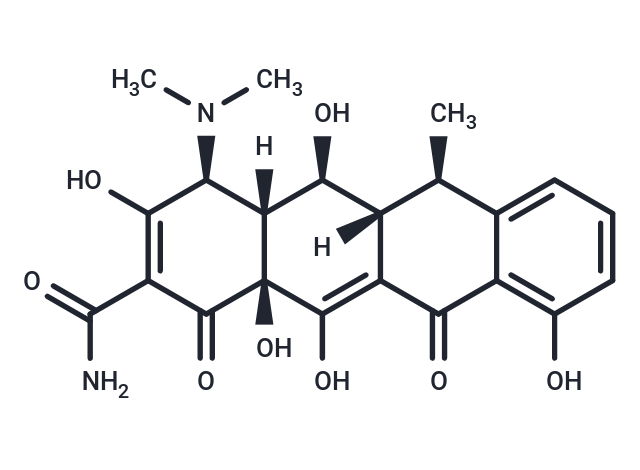Shopping Cart
Remove All Your shopping cart is currently empty
Your shopping cart is currently empty
Doxycycline is an orally active tetracycline antibiotic with broad-spectrum inhibitory effects on matrix metalloproteinases (MMPs), possessing both antibacterial and antitumor activities, and is commonly used in inducible gene expression ON-OFF systems.

| Pack Size | Price | USA Warehouse | Global Warehouse | Quantity |
|---|---|---|---|---|
| 10 mg | $30 | In Stock | In Stock | |
| 25 mg | $45 | In Stock | In Stock | |
| 50 mg | $72 | In Stock | In Stock | |
| 100 mg | $97 | In Stock | In Stock | |
| 500 mg | $173 | In Stock | In Stock | |
| 1 g | $256 | In Stock | In Stock |
| Description | Doxycycline is an orally active tetracycline antibiotic with broad-spectrum inhibitory effects on matrix metalloproteinases (MMPs), possessing both antibacterial and antitumor activities, and is commonly used in inducible gene expression ON-OFF systems. |
| Targets&IC50 | chlamydial isolates:0.497 μg/mL, A549 cells:1.06 μM, NCI-H446 cells:1.70 μM, Pancreatic Cancer cells (96 h):50.02 μM, Pancreatic Cancer cells (48 h):987.5 μM, Pancreatic Cancer cells (72 h):99.64 μM |
| In vitro | METHODS: Twenty-two tumor cells were treated with Doxycycline for 48 h. Cell viability was measured by MTT. RESULTS: Lung cancer cells were more sensitive to Doxycycline than most other cell lines. NCI-H446 and A549 cells were sensitive to Doxycycline with IC50s of 1.70 μM and 1.06 μM, respectively. [1] METHODS: Human pancreatic cancer cells PANC-1 were treated with Doxycycline (10-40 μg/mL) for 8-24 h. The cell cycle was detected by Flow Cytometry. RESULTS: Doxycycline caused the cells to arrest in the G1-S phase of the cell cycle. [2] |
| In vivo | METHODS: To detect anti-tumor activity in vivo, Doxycycline (50 mg/kg) was administered intraperitoneally once daily for fifteen days to BALB/c mice harboring human mammary carcinoma tumor 4T1. RESULTS: Doxycycline delayed tumor growth and reduced the number of tumor-associated macrophages and blood vessels. [3] METHODS: To assay antimicrobial activity in vivo, Doxycycline (40 mg/kg) was administered intraperitoneally to BALB/c mice exposed to B. pseudomallei 1026b twice daily for two weeks. RESULTS: Doxycycline-treated mice survived 100% of the time, and no B. pseudomallei DNA was amplified from the lungs or spleens of the majority of the surviving mice. [4] |
| Synonyms | Vibramycin, Doxytetracycline, Doxycyclinum, Doxiciclina |
| Molecular Weight | 444.43 |
| Formula | C22H24N2O8 |
| Cas No. | 564-25-0 |
| Smiles | [H][C@@]12[C@@H](C)c3cccc(O)c3C(=O)C1=C(O)[C@]1(O)C(=O)C(C(N)=O)=C(O)[C@@H](N(C)C)[C@]1([H])[C@H]2O |
| Relative Density. | 1.3809 g/cm3 (Estimated) |
| Storage | Powder: -20°C for 3 years | In solvent: -80°C for 1 year | Shipping with blue ice/Shipping at ambient temperature. | |||||||||||||||||||||||||||||||||||
| Solubility Information | DMSO: 200 mg/mL (450.01 mM), Sonication is recommended. | |||||||||||||||||||||||||||||||||||
| In Vivo Formulation | 10% DMSO+90% Saline: 4 mg/mL (9 mM), Solution. Please add the solvents sequentially, clarifying the solution as much as possible before adding the next one. Dissolve by heating and/or sonication if necessary. Working solution is recommended to be prepared and used immediately. The formulation provided above is for reference purposes only. In vivo formulations may vary and should be modified based on specific experimental conditions. | |||||||||||||||||||||||||||||||||||
Solution Preparation Table | ||||||||||||||||||||||||||||||||||||
DMSO
| ||||||||||||||||||||||||||||||||||||
| Size | Quantity | Unit Price | Amount | Operation |
|---|

Copyright © 2015-2025 TargetMol Chemicals Inc. All Rights Reserved.